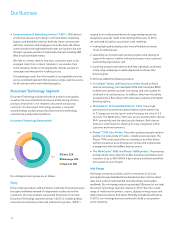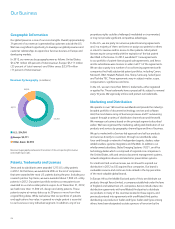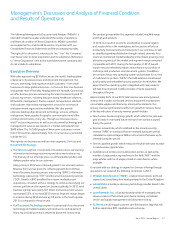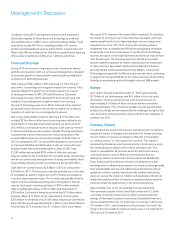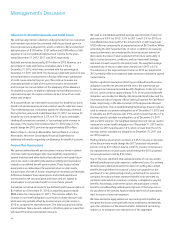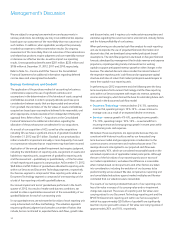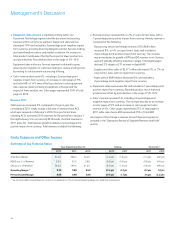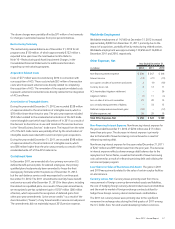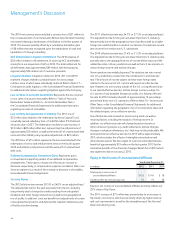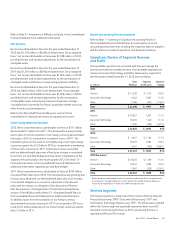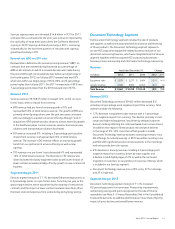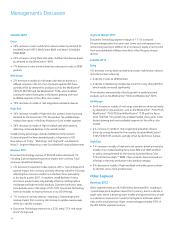Xerox 2012 Annual Report Download - page 34
Download and view the complete annual report
Please find page 34 of the 2012 Xerox annual report below. You can navigate through the pages in the report by either clicking on the pages listed below, or by using the keyword search tool below to find specific information within the annual report.Management’s Discussion
32
We are subject to ongoing tax examinations and assessments in
various jurisdictions. Accordingly, we may incur additional tax expense
based upon our assessment of the more-likely-than-not outcomes of
such matters. In addition, when applicable, we adjust the previously
recorded tax expense to reflect examination results. Our ongoing
assessments of the more-likely-than-not outcomes of the examinations
and related tax positions require judgment and can materially increase
or decrease our effective tax rate, as well as impact our operating
results. Unrecognized tax benefits were $201 million, $225 million and
$186 million at December 31, 2012, 2011 and 2010, respectively.
Refer to Note 16 – Income and Other Taxes in the Consolidated
Financial Statements for additional information regarding deferred
income taxes and unrecognized tax benefits.
Business Combinations and Goodwill
The application of the purchase method of accounting for business
combinations requires the use of significant estimates and
assumptions in the determination of the fair value of assets acquired
and liabilities assumed in order to properly allocate purchase price
consideration between assets that are depreciated and amortized
from goodwill. Our estimates of the fair values of assets and liabilities
acquired are based upon assumptions believed to be reasonable, and
when appropriate, include assistance from independent third-party
appraisal firms. Refer to Note 3 – Acquisitions in the Consolidated
Financial Statements for additional information regarding the
allocation of the purchase price consideration for our acquisitions.
As a result of our acquisition of ACS, as well as other acquisitions
including GIS, we have a significant amount of goodwill. Goodwill at
December 31, 2012 was $9.1 billion. Goodwill is not amortized but
rather is tested for impairment annually or more frequently if an event
or circumstance indicates that an impairment may have been incurred.
Application of the annual goodwill impairment test requires judgment,
including the identification of reporting units, assignment of assets and
liabilities to reporting units, assignment of goodwill to reporting units
and the assessment – qualitatively or quantitatively – of the fair value
of each reporting unit against its carrying value. At December 31, 2012,
$6.8 billion and $2.3 billion of goodwill was allocated to reporting units
within our Services and Document Technology segments, respectively.
Our Services segment is comprised of three reporting units while our
Document Technology segment is comprised of one reporting unit for
a total of four reporting units with goodwill balances.
Our annual impairment test of goodwill was performed in the fourth
quarter of 2012. As a result of market and business conditions, we
elected to utilize a quantitative assessment of the recoverability of our
goodwill balances for each of our reporting units.
In our quantitative test, we estimate the fair value of each reporting unit
using a discounted cash flow methodology. This valuation approach
requires significant judgment and considers a number of factors that
include, but are not limited to, expected future cash flows, growth rates
and discount rates, and it requires us to make certain assumptions and
estimates regarding the current economic environment, industry factors
and the future profitability of our business.
When performing our discounted cash flow analysis for each reporting
unit, we incorporate the use of projected financial information and
discount rates that are developed using market participant-based
assumptions. The cash-flow projections are based on five-year financial
forecasts developed by management that include revenue and expense
projections, capital spending trends, and investment in working
capital to support anticipated revenue growth or other changes in the
business. The selected discount rates consider the risk and nature of
the respective reporting units’ cash flows and an appropriate capital
structure and rates of return that market participants would require to
invest their capital in our reporting units.
In performing our 2012 impairment test, the following were the long-
term assumptions for Document Technology and the three reporting
units within our Services segment with respect to revenue, operating
income and margins, which formed the basis for estimating future cash
flows used in the discounted cash flow model:
• Document Technology – revenue decline: 2%-3%, operating
income: flat, operating margin: 10%-12% – as we continue to
manage costs as a result of an expected decline in revenues.
• Services – revenue growth: 4%-6%, operating income growth:
7%-10%, operating margin: 10%-12% – as we benefit from
recurring revenue and strong signings growth in recent years while
maintaining costs and expenses.
We believe these assumptions are appropriate because they are
consistent with historical results as well as our forecasted long-
term business model and give appropriate consideration to the
current economic environment and markets that we serve. The
average discount rate applied to our projected cash flows was
approximately 10%, which we considered reasonable based on the
estimated capital costs of applicable market participants. Although
the sum of the fair values of our reporting units was in excess of
our market capitalization, we believe the difference is reasonable
when market-based control premiums and other factors are taken
into consideration, including the evolution of our business to be
predominantly services-based. We also compared our reporting unit
and consolidated valuations against market multiples and likewise
concluded that our valuations were reasonable.
The results of our testing indicated that each of our reporting units
has a fair value in excess of its carrying value and no impairment
charge was required. The excess of reporting unit fair values over
carrying values for our Document Technology reporting unit and the
BPO/ITO Government reporting unit within our Services segment
(which has approximately $2.0 billion of goodwill) are significantly
less than in prior years with excess of fair value over carrying value of
approximately 20% and 10%, respectively.


